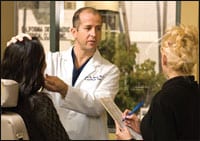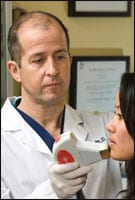 |
According to all available statistics, liposuction is the most popular aesthetic plastic surgery procedure sought out by patients. Although liposuction, also known as lipoplasty, slims and reshapes specific areas of the body by removing excess fat deposits, plastic surgeons warn that it is not an alternative to diet and exercise.
David M. Alessi, MD, FACS, a founding partner of Alpha Surgical Group in Beverly Hills, Calif, is outspoken on this score—liposuction is not a frivolous aesthetic surgery procedure, although many patients and even some physicians seem to see it as an effortless weight-control method.
“Patients who’ve already shed excess pounds and dropped to an ideal body weight—but can’t seem to lose fat accumulations by any other means—are the ones for whom liposuction is intended and appropriate,” Alessi says. “Before a person who is significantly overweight undergoes liposuction, he or she needs to get on a safe and effective weight-loss diet and begin frequenting a gym in order to rehabilitate his or her body.”
The public demand for many aesthetic procedures is in large part due to the mainstream mass media, Alessi contends. “The message from morning newscasts, afternoon talk shows, and sometimes even nighttime reality shows is that plastic surgery changes lives. Not can change lives. Will change lives, without fail and no matter what.”
In Alessi’s view, a poor candidate for aesthetic surgery is “someone who comes in for the initial consultation and says, ‘I don’t like the way my life is. Please do something to improve me. I think if you do such-and-such procedure on me, my life will be better and I’ll be happy. The procedure I’m talking about, I saw it done on TV and the patient seemed really happy afterward.’
“What this individual sitting across the desk from you needs is not a plastic surgeon, but sessions with a psychiatrist to uncover the real sources of his or her unhappiness and offer help in addressing those.”
IT TAKES TWO TO TANGO
Currently, the percentage of aesthetic surgeries that qualify as frivolous is difficult to tally. Alessi suspects that around 30% of all plastic surgery cases in the United States can be classed as unwarranted or ill-advised.
“Generally, the younger the patient, the greater the tendency to make frivolous requests,” he says. Also prone to that sort of thing are patients who suffer from body dysmorphic syndrome.
“The classic example of body dysmorphic syndrome is someone with anorexia nervosa—a person who measures 5 feet 10 inches but weighs 80 pounds and nevertheless is convinced he or she is horribly fat.”
Still, frivolous surgery requires the consent of a patient and the cooperation of a physician. “Many unwarranted procedures are financially driven,” Alessi says. “When a poor candidate for surgery presents, some plastic surgeons who aren’t as busy as they’d like to be will go ahead and schedule the procedure. They incorrectly reason that if they don’t accommodate the patient’s desire, the plastic surgeon down the street will.”
At times, physicians who take on patients for unnecessary face or body work do so because they are new to the field and want to hone their skills. Again, it is a case of “doctor beware.”
“You have a person who is unhappy for reasons having little to do with a specific body defect, and you agree to perform the requested procedure,” Alessi adds. “All you’re doing here is setting the stage for patient dissatisfaction.
“With such a patient, it’s likely he or she will still be unhappy after surgery. That means no matter what you do, no matter how excellent your work, the patient will perceive that his or her life was not improved by the surgery and will go around telling family and friends to avoid you as a plastic surgeon.
“In my opinion, it’s ludicrous to take on as a patient someone who is almost preprogrammed to be dissatisfied with the results. It’s a very painful way to practice.”
Given the mainstream media’s unyielding penchant for sensationalism and the financial pressures weighing on some plastic surgeons, putting the brakes on all frivolous surgeries could be a daunting task.
Even so, Alessi hopes it can be done. No doubt it would help, he suggests, if consumers recognized that they could delay going under the knife (or avoid it altogether) by taking better care of their skin, face, and body.
“For example, people should curtail their exposure to ultraviolet radiation; they also should start a good regimen of skin care while still young,” he proposes.
VOICE VERSA
 |
| During a consultation at his Beverly Hills office, Alessi stresses the importance of choosing the right candidates for aesthetic surgery. Some physicians take on patients for the wrong reasons, he says. |
Alessi is outspoken about frivolous aesthetic surgery because he is passionate about delivering quality—a hallmark of his practice since 1989, the year he completed extensive facial plastic and reconstructive training in head and neck surgery at the University of California at Los Angeles (UCLA), preceded by an internship at nearby Cedars-Sinai Medical Center.
“I make a point of considering how any cosmetic work of the nose, mouth, or other facial and neck structures will affect the quality of the patient’s voice,” he says, asserting that functional issues constitute an overlooked aspect of aesthetic surgery.
“For me, function is every bit as key as the cosmetic aspects. To illustrate what I mean, if the corners of the mouth are tightened up too much, it can interfere with the way the patient forms words or lyrics. Likewise, if even a minor occlusion of the nasal airway results from a rhinoplasty, it can interfere with the operation of the larynx and resonation of the vocal cords.
“My goal is to make sure that when I beautify the face, I don’t at the same time inadvertently alter the beauty of how that person sounds,” he continues. “That’s why I rely on surgical procedures proven to preserve or even enhance function.”
Invasive procedures performed by Alessi include endoscopic browlifts, transbleph browlifts, blepharoplasty, ear-correction surgery, rhinoplasty, revision rhinoplasty, facelifts, and U-lifts.
The U-lift is a trademarked procedure developed by Alessi that entails a well-camouflaged incision around the ears to lift and recontour the lax tissue at the level of the chin and neck. It also involves tightening the related deeper structures while at the same time using excess underskin to contour the cheek folds so that a more natural appearance is achieved at a fraction of the postoperative downtime and discomfort normally associated with a traditional facelift.
Meanwhile, on Alessi’s roster of noninvasive procedures are laser rejuvenation, laser hair removal, facial augmentation using fat and autologous materials, photofacials, peels, injectables, and treatments using botulinum toxin Type A.
INNOVATIONS R US
 |
| Alessi’s noninvasive procedures include facial augmentation using fat and autologous materials. |
According to Alessi, quality derives from skill coupled with innovative technique. An example of this maxim is the way Alessi performs the majority of his browlifts, eschewing incisions on the forehead.
“Instead, I use a single retrograde dissection through the upper lid using the Endotine transblepharoplasty browlift implant technique,” he reveals.
The Endotine implant is a relatively new device used to lift brows through an incision of the eyelid crease (see related story, page 26).
“This approach releases the brow structures not just in proximity to where the Endotine implant will be placed, but also far more medially, because also removed are some of the glabella and procerus musculature,” Alessi says.
“As a result, it’s possible to take care of the entire brow with a lone translid incision. This makes an ideal method for patients who only need a small amount of temporal browlift, since the size of the implant and its placement limits the length of brow that can be lifted.”
Endotine implants are available in 3-mm and 3.5-mm sizes. The larger of the two tends to work best for thicker brows because of the need to support more weight.
The Endotine implant procedure, following lid-crease incision, continues with dissection of the anterior lamella, beginning at the posterior lamella and extending all the way to the superior orbital rim. Next, the periosteum is incised and a subperiosteal is dissected several centimeters above the brow. Then, a hole is drilled no less than 4 mm above the rim with the help of a disposable bit. (One accompanies each individually packaged implant.)
With the hole completed, the implant is inserted and tissues are engaged. Adjustments to the brow height can be made in a few easy steps involving the dislodging and repositioning of the tissues. In their final position, the tissues hold securely enough to prevent the brow from dropping—provided the patient is careful not to jostle that area of the face until healing is complete, Alessi cautions.
The Endotine transblepharoplasty browlift implant technique is valuable because by eliminating the need for the forehead incision, it leaves no visible reminder that a cut was made. Also, the implant is bioabsorbable within 7 months of placement.
EXPANSION INTO RETAIL
In support of his invasive and noninvasive services, Alessi in 2006 unveiled a line of antiaging skincare products. He developed them by drawing on skills he first acquired as an undergraduate biochemistry honors student at Michigan State University (East Lansing, Mich), as a PhD candidate at Wayne State University in Detroit, and, finally, as an immunology researcher at UCLA.
“Through extensive investigation over the years since then, I found it possible to identify the optimal concentrations of key ingredients,” he says.
According to Alessi, the marketing claims of a skincare product have to withstand scrutiny. Products must be subjected to double-blind controlled studies—or, at the very least, go through a validated clinical research process.
“The problem with most of the cosmetic agents sold today is they have none of this kind of evidence behind them, nothing to support the claims—and that is something I’m troubled by,” he says.
However, Alessi finds reason to cheer in the nascent trend among skincare products manufacturers to back up their claims with good science.
The FDA does not require skincare product manufacturers to back up their marketing claims.
“That’s voluntary,” he says. “But it’s nice to see compliance on the rise. I think a big driver for this is the competitive pressures of the marketplace. Companies want an edge with increasingly skeptical consumers, and being able to demonstrate a scientific basis for a product’s claims is one way to gain the advantage.”
Nonetheless, not every show of evidence is trustworthy, Alessi contends. “You’ll see products supported by ‘studies’ insisting that some very high percentage of patients tested have indeed experienced antiaging benefits from using a particular cosmetic agent. But, in reality, the study is nothing more than the company conducting a survey of purchasers to find out if any of them feel they were helped by the product. That’s hardly scientific.”
FACE OF THINGS TO COME
Alessi’s love of medical science flourished during the years he practiced under the tutelage of an older physician, Gene Flaum, MD, with whom he partnered after completing his residency.
They parted company amicably in 2000 because Flaum, who was close to retirement, no longer shared Alessi’s interest in growing their practice.
On his own, Alessi discovered the need for an associate who could handle ear, nose, and throat cases while Alessi concentrated on facial aesthetic surgery.
He found the ideal colleague in Babak Larian, MD. Soon afterward, Alessi needed another associate to help him expand the aesthetic surgery side of his business. As a result, Babak Azizzadeh, MD, FACS, joined Alessi’s practice, and in 2003 the three physicians formed Alpha Surgical Group. Two more physicians have since been brought aboard.
Many of the surgeries performed by Alessi take place in a 5,000-square-foot ambulatory center located a few blocks from Alpha Surgical Group’s offices. Other procedures are conducted at Cedars-Sinai Medical Center and nearby hospitals.
Alessi strongly believes in charitable giving. His newest philanthropic endeavor is a nonprofit organization called Face Forward, which will offer an outreach program to women and children who have suffered disfigurement at the hands of violent inner-city gangs.
 |
| See also “Hands Off!” by Jacob Stein, JD, in the February 2007 issue of PSP. |
After Face Forward receives its certification as a nonprofit organization, Alessi hopes to provide reconstructive surgery services free of charge “to deserving patients identified by us and our partners in the church and public-sector social-worker community,” he explains.
“Our vision is to initially handle one of two such cases each month. Then, as the charity grows in donor participation, we hope to be able to increase the monthly caseload,” he adds.
In addition, Alpha Surgical Group is currently so busy that Alessi and his partners are casting for a sixth physician to join the team.
“Our goal is to have none but the city’s finest surgeons under this one roof,” he says. “In cosmetic plastic surgery, it’s all about safety and efficacy. Another way to express that is by saying it’s all about quality. People come to us for quality. We’re going to make sure they always receive it.”
 |
Surgeon Connoisseur
The weather in California was on the dry side last summer, so it is entirely possible that vintners in the Golden State will have an advantage over their counterparts in France when it comes to body, bouquet, and taste, according to David M. Alessi, MD, FACS.
Alessi can make such a prediction because wine collecting occupies a spot at the top of his list of personal interests (a pleasureful pastime he shares with his bride, whom he wed only this past October).
Ask him to suggest a good wine, and Alessi is quick to instead recommend consulting the latest issue of Wine Spectator for advice about specific labels.
“It would be easier to tell you the wines I don’t like than those I do,” he claims. “But, in short, I’m particularly fond of Sauternes and Oregon Pinot Noir. Lately, I’ve been on a French light burgundy kick because California Chardonnay is a little too acidic for me. A couple of years ago, Wine Spectator was touting a Zinfandel variety called Seghesio. At the time, it was the world’s 11th best-rated wine. The interesting thing was that it was only $17 a bottle, while the wines ranked ahead of it and behind it cost hundreds of dollars per bottle. I mention this only because, to me, a good wine is one that is highly regarded but, at the same time, a great value.”
Beyond wine collecting, Alessi enjoys travel, gourmet cooking, and sports.
“I love staying in shape with weight lifting and aerobics,” he says. That, of course, makes it easier for him to participate in snow skiing, running, and bicycling, three of his other favorite activities. Worth noting, too, is Alessi’s past involvement with the Los Angeles Mozart Orchestra (he previously served as a member of its board of directors).
On the professional front, Alessi’s dossier is no less impressive. His record includes service as the chief of the Division of Otolaryngology at Cedars-Sinai Medical Center in Los Angeles, president of the Cedars-Sinai Alumni Association, president of the Paul Ward Society, and an appointee to the California State Senate’s medico-legal advisory committee as well as vice-chief of the Golden State’s Speech and Audiology Examining Committee.
Additionally, Alessi holds dual assistant clinical professorships at UCLA and Cedars-Sinai Medical Center, where he is involved in ongoing research regarding voice disorders, facial reconstruction, and head/neck oncology. Alessi holds two patents on laryngeal endotracheal tubes he developed.
His resume lists authorship of more than 200 scientific articles, book chapters, abstracts, and presentations. It also notes that he is a member of the American Medical Association, American Academy of Otolaryngology-Head and Neck Surgery, American Academy of Facial Plastic and Reconstructive Surgery, and other professional societies.
—RS
Rich Smith is a contributing writer for PSP. He can be reached at [email protected].





